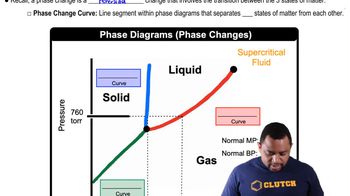The graph below shows the change in pressure as the temperature increases for a 1-mol sample of a gas confined to a 1-L container. The four plots correspond to an ideal gas and three real gases: CO2, N2, and Cl2. (b) Use the van der Waals constants in Table 10.3 to match the labels in the plot (A, B, and C) with the respective gases 1CO2, N2, and Cl22.
(c) Which is most likely to be a gas at room temperature and ordinary atmospheric pressure, F2, Br2, K2O?
 Verified step by step guidance
Verified step by step guidance
Verified video answer for a similar problem:
Key Concepts
States of Matter

Molecular Weight and Intermolecular Forces

Phase Diagrams

Which of the following statements is false? (a) Gases are far less dense than liquids. (b) Gases are far more compressible than liquids. (c) Because liquid water and liquid carbon tetrachloride do not mix, neither do their vapors. (d) The volume occupied by a gas is determined by the volume of its container.
(b) Which units are appropriate for expressing atmospheric pressures, N, Pa, atm, kg/m2?
Suppose that a woman weighing 130 lb and wearing high-heeled shoes momentarily places all her weight on the heel of one foot. If the area of the heel is 0.50 in.2, calculate the pressure exerted on the underlying surface in a. pounds per square inch,
Suppose that a woman weighing 130 lb and wearing high-heeled shoes momentarily places all her weight on the heel of one foot. If the area of the heel is 0.50 in.2, calculate the pressure exerted on the underlying surface in c. atmospheres.
A set of bookshelves rests on a hard floor surface on four legs, each having a cross-sectional dimension of 3.0×4.1 cm in contact with the floor. The total mass of the shelves plus the books stacked on them is 262 kg. Calculate the pressure in pascals exerted by the shelf footings on the surface.
